US Army of Occupation WW1
The Army of Occupation is the designation given to troops assigned to serve in Germany, Austria, and Hungary for postwar service between November 12, 1918, and July 11, 1923.
By U.S. Department of Defense. Department of the Army. Office of the Chief Signal Officer. - This media is available in the holdings of the National Archives and Records Administration, cataloged under the National Archives Identifier (NAID) 530707., Public Domain, https://commons.wikimedia.org/w/index.php?curid=880927
Wounded Poilus cheer the American division as it marches by in the Bastille Day parade.
"Every American who marched was over six feet tall.".
National Archives Photo
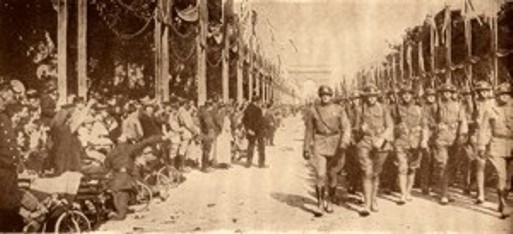
“On November 11, the refugees began coming through the lines in the forenoon. They were extremely destitute, being very inefficiently clothed. Most of them found their homes destroyed. They had no funds, so a bread and soup kitchen was opened for them in the Hotel de Ville. For shelter, these refugees were quartered in cellars and other parts of large, empty buildings such as stores and warehouses.“The soldiers cleaned up the city while occupying it; hauled refuse such as brick and plaster from the streets. Moved church property from a place of storage in the convent, back to the churches not destroyed.
All bridges across the Scheldt were mined and these mines are thrown as soon as the American entered the city and they all had to be rebuilt.”
Emmett Alexander Lewis, Private, 33rd Div.,
Marion County, Indiana
Distinguished Service Award, by Major General George Bell Jr., on the recommendation of the regimental commander, Col. John H. Clinnin and General Commander of the 65th brigade, Edward L. Kane for gallantry and splendid performance of duty as a “Runner” at Consenvoye on October 10, 1918, and that name and action to be inscribed on the Roll of Honor, Prairie Division.
The 33rd, known as the Prairie Division, commanded by Major General George Bell Jr. was the only Division in the E. F. and therefore in American history, which fought with the British and French and Australians.
As a member of this Division, I participated in its activities from June 22 to November 11, 1918, for a period of nearly five months when the Division actually held a portion of the Allied lines.
I served with five armies, namely the 1st; 2nd; and 3rd; American, the 2nd French Army, and the 4th British armies, also 12th Army Corps with England, 2nd, 3rd, 4th, 5th, 6th and 7th American Army Corps, the 2nd and 17th French Army Corps and the 3rd Australian Army Corps.
After the armistice, I marched with the Division to Lorraine and Luxembourg and was in Germany for a brief period as part of the Army of Occupation and was later stationed at Beaufort, Luxembourg, north of said Army of Occupation until May 11, 1919, when we were officially ordered back to the States.
Army of Occupation Medal
The Army of Occupation Medal commemorates service in the occupation of Germany or Austria-Hungary after WW1. General Pershing appears o the front side, this photo reflects the back of the medal. The Bald Eagle is perched atop the Castle Ehrenbreistein, the symbolic gateway to Germany where the Rheine and Mosel Rivers meet. The three stars represent the number of Armies that participated in the Occupation.
Medal from Indiana War Memorial Archives
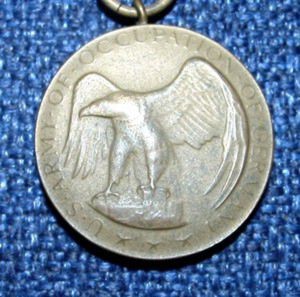
This medal was established retroactively in 1941, due to the rising tension in Germany. It was authorized November 21, less than three weeks before Pearl Harbor.
Soldiers stories:
Emmett Alexander Lewis, Private, 33rd Div.
Marion County, Indiana
Distinguished Service Award, by Major General George Bell Jr., on the recommendation of the regimental commander, Col. John H. Clinnin and General Commander of the 65th brigade, Edward L. Kane for gallantry and splendid performance of duty as a “Runner” at Consenvoye on October 10, 1918, and that name and action to be inscribed on the Roll of Honor, Prairie Division.
The 33rd, known as the Prairie Division, commanded by Major General George Bell Jr. was the only Division in the E. F. and therefore in American history, which fought with the British and French and Australians.
As a member of this Division, I participated in its activities from June 22 to November 11, 1918, for a period of nearly five months when the Division actually held a portion of the Allied lines.
I served with five armies, namely the 1st; 2nd; and 3rd; American, the 2nd French Army, and the 4th British armies, also 12th Army Corps with England, 2nd, 3rd, 4th, 5th, 6th and 7th American Army Corps, the 2nd and 17th French Army Corps and the 3rd Australian Army Corps.
After the armistice, I marched with the Division to Lorraine and Luxembourg and was in Germany for a brief period as part of the Army of Occupation and was later stationed at Beaufort, Luxembourg, north of said Army of Occupation until May 11, 1919, when we were officially ordered back to the States.
John Mae Kennedy, Signal Corps
Huntington County, Indiana
Served with the Army Occupation in Diekirch, Luxembourg.
“My father was a Civil War veteran, my grandfather was a Mexican war veteran and both of my great-grandfathers served in the Revolutionary war.
Charles Laurence Corneille, FA
Allen County, Indiana
PFC, Battery B, 150th Field Artillery, 42nd Division “Was with the 3rd Army of Occupation. Our march to Germany started at Harricourt Depot, Ardennes, France, and terminated at Neuenahr, Germany. During this march, we were reviewed by President Poincare of France at Montmedy on November 20, 1918.
Our division was the only American organization in General Gourand’s Army (which checked the greater enemy offensive,) namely the attempt to break through to Paris on July 15-16, 1918.”
Earl Emerson Monroe, 315th Ammunition Train
Marion County, Indiana
"The 315th Ammunition Train, most of whom were members of Purdue auto school, formed at Camp Mills, Long Island. These men were at Purdue two months, commanded by Captain Tompson. At Camp Mills, we were taken in as the aforesaid originators. Later our numbers were increased with men from Massachusetts from similar schools. Later we were increased with some transfers from the aviators after we arrived in France we were filled up with casuals.
"We left New York, landing in Liverpool, England. We traveled in a Train and on foot to Southampton. Crossed the Champagne to Surbourg France, then by boxcar to Locarno, France not far from Bordeaux. We were trained there and were equipped. We went by truck overland to Bordeaux to Remicourt, 50 miles below Verdun, a 10-day trip. We passed through beautiful mountains and flats, then through Verdun to Stenay, the place of the last stand of the Germans on the American sector. We saw many things the Huns had left behind. Then through Luxembourg into the country of Germany with the Army of Occupation. We were located near Berncastle on the Mozelle river, some 60 miles from Coblentz. We saw many historic scenes on the Mozelle and Rhine Rivers.
"We left Germany in May, went through Alsace-Lorraine, a beautiful country, to St. Asane then to Boston.
"The 90th division was originally formed in Texas, made up with Oklahoma and Texas men. Some of these and were taken out before the division left Camp, and we were put in their place. T. O. in this manner was their insignia."
Elmer M. Cox, Goldstar, Gold Star
Marion County. Indiana
Died of pneumonia in France while serving with the Army of Occupation, the family notified 11/11/1919.
(Not found in Gold Star Book or IWM list.)
Born January 11, 1894, in Indianapolis; son of D. L. (deceased) and Blanch Cox, 2438 Cornell St., Indianapolis, IN. Conscripted into service September 1917. Assigned to Signal Corps and trained at Camp Sherman, Ohio. “Died in France of pneumonia – received word March 11, 1919” American War Mothers information included in “ Marion County in the World War, Vol. 1” records, Indiana State Library, I940.3772.M3413 V1.
Name located in American Soldiers of World War I, Soldiers of the Great War, Vol. 1.
John Simeon Smith, Co. A, 18th Infantry, Ripley County, Indiana
Decorated for five major operations; Montdidier, Moyon, St. Mihiel, Aisne-Marne, Meuse-Argonne. Served with Army of Occupation in Germany and was in all of First Division parades. Wife was killed in an accident in October 1919. He brought the Company mascot, a French Bulldog, home with him. His dog went through the entire service.
WWVets.com
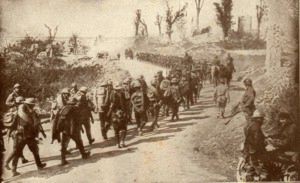
"Part of the American army of occupation on its way to Germany. After celebrating for awhile the announcement that the armistice had been signed, the American troops at the front realized that there was still serious work, though of a different kind, ahead of them, and started for the cities across the Rheine with a firm determination to carry on 'till all the fruits of their victory were obtained. An American dispatch rider is seen at the right, fraternizing with a French soldier."
French Official photo from U & U, America's War for Humanity
World War 1 Poster courtesy of Indiana War Memorial Archives
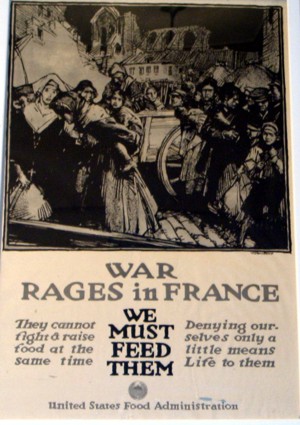
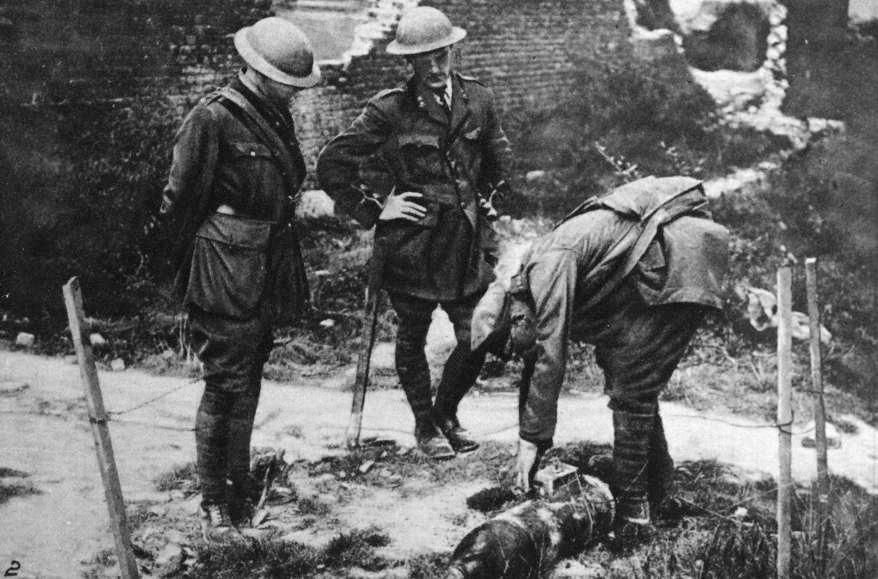
British Bomb Disposal Unit
By John Warwick Brooke - 1918 edition of "The War Pictorial" magazine IWM. This is photograph Q 6017 from the collections of the Imperial War Museums., Public Domain, https://commons.wikimedia.org/w/index.php?curid=2844219